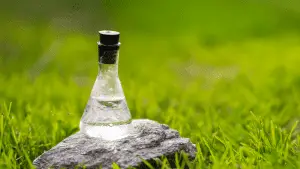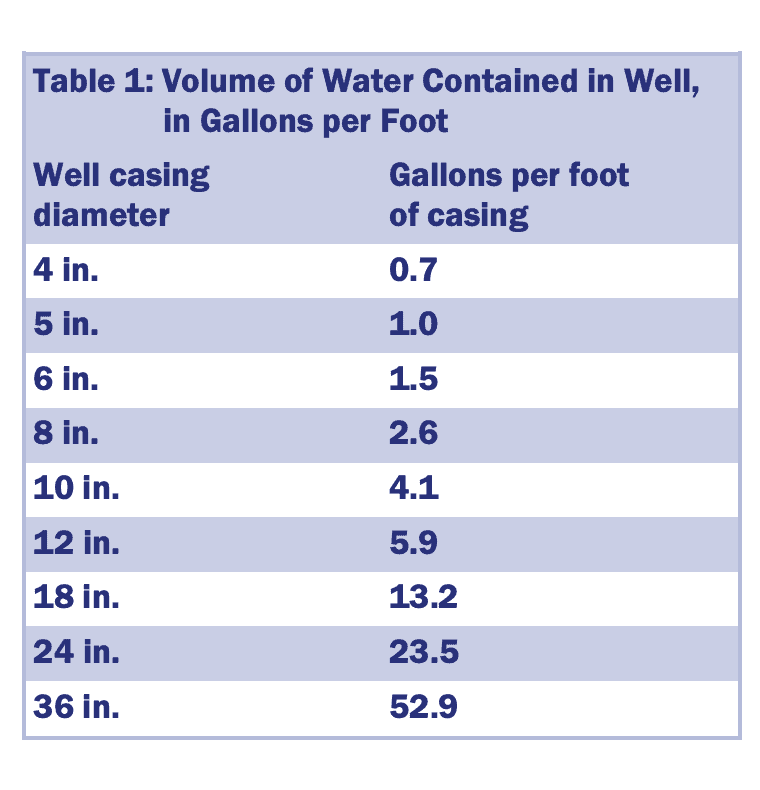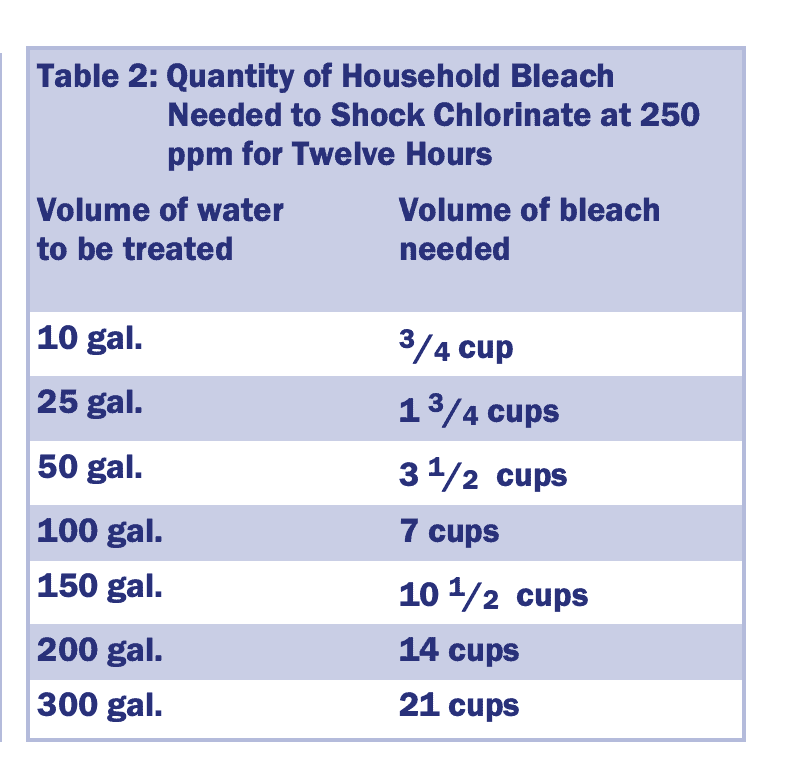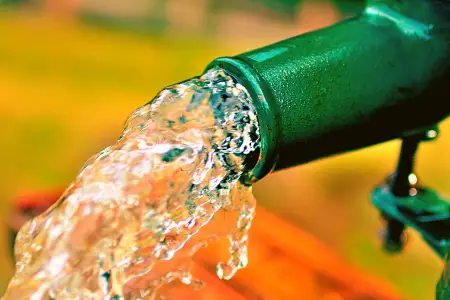You’ve tested your well water for coliform bacteria and it has come back positive. Now what?
Most strains of coliform bacteria won’t cause problems and are perfectly safe. The problem is that there are some forms of E Coli that are very dangerous and fecal coliform are all unsafe to drink.
Time to bring out the big guns and get to work shocking your well. If you want to know how to remove coliform bacteria from your well water, then this is the most effective method.
There are also other bacteria like iron and sulfur bacteria that are not a health threat but are the cause of that rotten egg smell common in well water. This method will take care of them too.

How To Shock A Well With Bleach
Before I get into the tips for how to proceed, let me say that this and other types of well disinfection procedures should be done with the thought that you’re not going to have drinking or bathing water for a while.
In the case of shocking with bleach, plan to do this procedure when you won’t be needing any water for at least 24 hours. Before you get started know that disinfection will take up all your water supply (well and household).
Materials needed to Shock your Well with Bleach
- Household Bleach (5.25% Chlorine)
- Goggles
- Gloves
- 55 Gallon Bucket
- Chemical Resistant Apron
How much water is being treated?
Once you have your materials, you need to figure out how much water you are treating. Use the formula below to calculate the total volume of water you’re treating.
Step 1: Calculate Standing Water
First you need to figure out standing water using the calculation below:
Standing water = Depth of well – depth to water from top of well
Step 2: Determine Well Volume
Once you have calculated your standing water, you then figure out the total volume of water based on its diameter.
First use the chart below to determine your “gallons per foot of casing” based on your well casing diameter.

Once you have this number, multiply it by your standing water to get your total volume of well water.
Volume of well water = Standing Water X Gallons per foot of casing
Step 3: Calculate Total Volume of Water
You’ve already calculated your well water volume. Next, you need to calculate the total volume of water you’re treating in addition to well water. This includes your entire indoor plumbing. To get the total volume, use the formula below.
Total volume (gal.)= Water in Well (gal.) + Water in Pressure Tank (gal.) + # of toilets X 3 gallons + 10 gallons (plumbing distribution system) + water heater volume (gal.)
Calculate How Much Bleach to Use
It’s critically important to get the right amount of bleach. Too little and you won’t be killing the bacteria. Too much, and you risk corroding your well.
You want to get your chlorine concentration to 250 parts per million (ppm). As a basic rule of thumb, one gallon of bleach treats up to 250 gallons of water.
To get the exact volume of bleach you need to treat your well water, use this chart below.

If you took the time to run all the calculations, you’ll get a more precise amount of bleach that you need to use. If you want more of a ballpark number, you can use the chart below.
| Casing Diameter | Well Depth | Well Depth | Well Depth | Well Depth |
|---|---|---|---|---|
| 0 to 50' | 50 to 100' | 100 to 200' | 200 to 300' | |
| 4" | 8 ounces | 16 ounces | 24 ounces | 1 quart |
| 6" | 1 quart | 2 quarts | 1.5 gallons | 2 gallons |
| 8 to 12" | 1 gallon | 1.5 gallons | 2 gallons | 2.5 gallons |
| 12 to 16" | 1 gallon | 2 gallons | 4 gallons | 6 gallons |
| 20 to 24" | 2 gallons | 6 gallons | 10 gallons | 14 gallons |
How to Shock Your Well with Bleach | Step by Step
- Shut Off Filters
Bypass or shut off all activated filters, including whole house or point of use reverse osmosis systems.
- Mix The Solution
Pour required bleach into your bucket. Fill 10 gallons of water for every gallon of bleach.
- Remove well cap
Remove your well cap and use a funnel to pour your solution down the well. Make sure you pour it in a way that it comes in contact with the sides of the well to maximize the exposure of the solution with the bacteria that may be on the casing.
- Get Water To All The Fixtures
Turn on a faucet and wait until you smell the bleach. Turn it off and do the same at another faucet. Open all the fixtures one by one including the shower, bath and outside faucets and flush the toilets.
- Circulate The Water
Attach a hose to the outside faucet and run the open end of the hose into the well casing. Turn the water on so that you can circulate the water through the well for about 15 minutes.
- Wait
Let the bleach mixture sit in the well for at least 12 hours but 24 is better. Don’t drink or bathe in this water at all.
- Flush It Out
Run all of your fixtures until the smell of bleach has disappeared or at least is barely noticeable.
While you are letting the water runoff, try to avoid the waste water from entering your septic system. Also, don’t let any of the outside faucets run the water towards any vegetation or garden as the bleach water will kill your plants.
You will likely have some chlorine left in the water for up to a week. You’ll want to use a chlorine filter to get rid of the chemical. It is safe to drink at this point, but it is best to avoid drinking it or bathing in it.
Read all about the side effects of chlorine and how to remove it.
If there is a source of contamination that persists then you may be getting bacteria in your well again. Make sure that you test your well again after a few weeks. If it is positive again you will need to find the source of the contamination. Call a well water expert at this point to check out your well.
If you don’t have any bacteria after a few months then you should be fine. Continue to test once per year to make sure.
Take a look at this quick video to see the proper technique and preparation for shocking your well.
After you’ve shocked your well, make sure you have a water test ready to see if any bacteria is still present. If you’ve tested positive for coliform then you should be testing your well every month or two.
How To Shock A Well With Chlorine
The same step by step guide above is the exact same method to use for shocking a well with chlorine to remove bacteria.
The only difference is how much chlorine to use. A 100-ppm chlorine concentration is ideal for sanitizing a well. Dry pellets are most commonly used to shock a well with chlorine. Something like Well Safe are the most common among well owners and work very well.
- EASY TO USE: Simple to follow DIY instructions are included in each Well...
- ELIMINATE BAD SMELL: Kills bacteria to provide disinfection and remove...
- COST-EFFECTIVE: No need for costly filtration systems or expensive well...
- EVERYTHING YOU NEED: Kit contains BWI Chlorine Calcium Hypochlorite...
- WATER SANITIZER: USDA food grade water purifier calcium hypochlorite...
| Casing Diameter | Gallons of Water Per 100 Feet | Recommended Ounces of Dry Chlorine |
|---|---|---|
| 4" | 70 | 1.3 |
| 6" | 150 | 2.9 |
| 8 to 12" | 260 | 5.1 |
| 12 to 16" | 590 | 11.6 |
| 20 to 24" | 2350 | 46 |
Make sure that you add the pellets to the water before adding to the well water. Don’t put the pellets into the bucket and then add water as it will cause a reaction that could send you some toxic fumes. Adding the pellets to the water will avoid this.
Alternatively, if you are a well owner you should look into a chlorinator system so you can easily shock your well when needed. Some well owners like to shock their well once per year to be on the safe side.
If you are one to periodically test and treat your well, then using a metered pump dispenser with a polyethylene tank is a very effective and easy way to chlorinate your well.
- 15 Gallon Chemical and Solution Tank
- Marked measurements (5, 10, & 15 gallons)
- Large Opening- 3.75" inside diameter
- Tank measures 14.5 inches in diameter and 24 inches tall.
Since there are other things that can contaminate your well, this system is great because you can use different solutions to disinfect. All you have to do is load up the tank with whatever disinfectant solution is called for and then run the pump. Mixing is easier and safer when you use a chlorinator system.
Frequent testing and the possibility of needing to shock your well every year or two is something that comes with the responsibility of owning a well, unfortunately.
Learn More!
After you’ve shocked your well, you’ll need a good filter if you don’t already have one. Check out this article about the best filters for coliform to see which one is best for your needs.
FAQ About Shock Chlorination
Yes, it is possible to use too much bleach. In fact, too much bleach can corrode the metal parts in your well and lead to damage with the well not functioning properly.
Also, the chlorine will linger in your water and you may need to filter the water for a while while testing periodically before the parts per million are low enough to not be a problem.
If you hire a company to do it, it can cost anywhere around $100 depending on where you live. Doing it yourself will only cost as much as the chlorine, 10 gallon bucket and the safety supplies to do it. If you buy a chlorinator system, then the initial cost is in the hundreds of dollars but you’ll have an easy system to use for years to come without ever needing a professional.
You should be testing your well once per year and shocking according to what the test results say. If they come back as safe to drink every time, then you don’t need to shock your well at all. If you want to feel safe, then every 3 to 5 years is good enough unless your tests do come back as being contaminated.
You likely have some heavy metals in your water with the most likely culprit being iron. You’ll need to use a well water test for heavy metals to see if that is why your water is turning brown after using bleach or chlorine.
Conclusion
If you are thinking of shocking a well for coliform but are intimidated then I hope this article has shown you that it isn’t as scary a thought as it seems.
Of course, you do need to be careful and take precautions as it can be dangerous when you are handling chemicals like chlorine. With some preparation, patience and this guide, you can make sure that your well is safe for you and your family.

Nick Lopresti is the founder of YourH2Home and a home improvement expert. He has years of experience writing about various home improvement topics, mostly as it pertains to water systems.

![Well Water Test Kit for Drinking Water - Quick and Easy Home Water Testing Kit for Bacteria Nitrate Nitrite pH Manganese & More | Made in The USA in Line with EPA Limits [NO MAILING Required]](https://m.media-amazon.com/images/I/51vBy0sRaxL.jpg)



